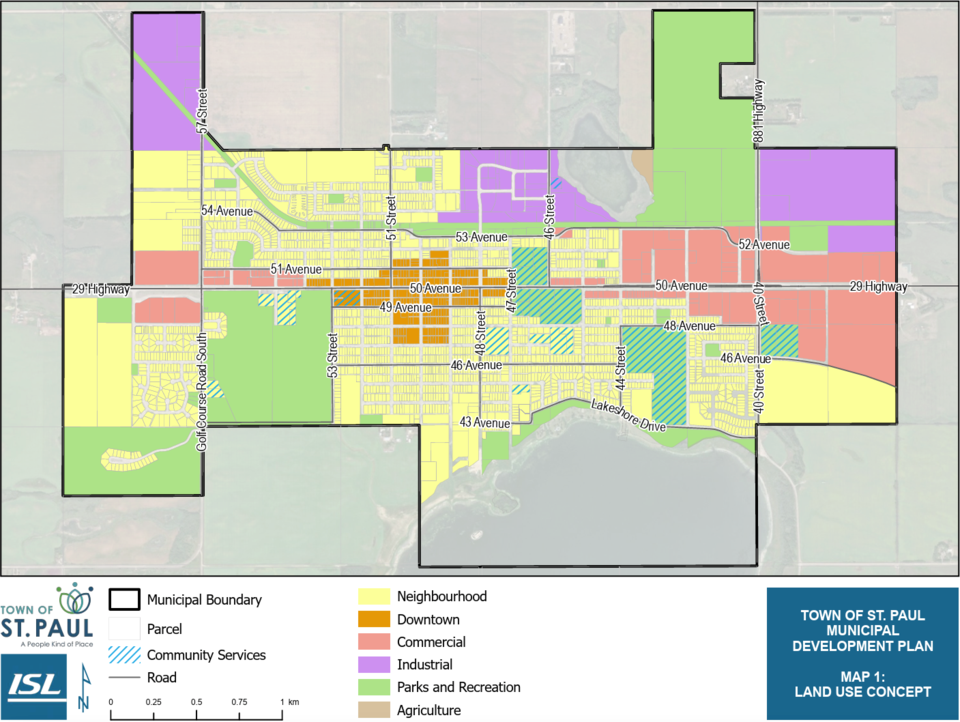ST. PAUL – The Town of St. Paul passed the second and final reading of its draft Municipal Development Plan (MDP) during the town’s council meeting on July 14, following a public hearing.
Council passed the first reading on June 23 after a round of public engagement sessions in late 2024 and in May.
The plan outlines the town's vision for growth and development over the coming years. It focuses on five key areas, including growth management, housing, downtown revitalization, future land concepts, and sustainability and climate resilience, said Mayor Maureen Miller during the public hearing, prior to the passing of the MDP.
Growth
Growth management, she said, involves ensuring sustainable development of the town.
According to the draft MDP, while the Town experienced modest growth of about 0.6 per cent from 2016 to 2021, the plan anticipates a population of about 7,400 by 2050 under a medium-growth scenario.
The Town plans to monitor demographic and employment trends, as well as promote St. Paul as a regional hub to help achieve this, which involves designating enough land for residential, commercial, and industrial expansion.
Housing
“Our second pillar was diverse housing [and] creating a variety of housing options for different needs and income levels,” said Miller.
To do this, the plan involves encouraging new residential areas to follow connected street grids, instead of cul-de-sacs, for example, to improve mobility and access to amenities. This could mean mixed-use developments in new neighborhoods.
For future growth on undeveloped lands, the plan targets a density of 20 units per acre, according to the MDP.
And to ensure a mix of housing types, new residential developments, through Area Structure Plans, aims for a maximum of 80 per cent low-density homes like detached houses and duplexes, and a minimum of 20 per cent medium to high-density types like townhomes and multi-unit dwellings.
The Town will also develop a housing strategy for affordable housing, which the plan defines as homes that cost no more than 30 per cent of a household’s income.
Downtown revitalization
As for downtown revitalization, which is the third key area of development for the plan, this initiative is about “revamping the downtown area to make it more vibrant and attractive,” to attract more businesses, boost economic diversity, and enhance public spaces for both residents and visitors, said Miller.
The plan involves adopting a Downtown Area Redevelopment Plan (DARP), which will include design guidelines for building facades, signage, and landscaping to create a more cohesive look for the downtown area.
Future land concept
“Future Land Concepts,” according to the plan, refers to how the Town of St. Paul envisions using and developing land in the years to come.
This approach aims to move away from large areas with only one type of use and disconnected street designs.
Instead, future development will prioritize compact and mixed-use development, like integrating homes, shops, and community facilities, and enhancing connectivity and accessibility through well-connected street networks, as well as efficient use of existing infrastructure through infill and redevelopment.
Sustainability and climate resilience
Sustainability and climate resilience, another key area of the MDP, involves “adapting to climate change through eco-friendly policies and practices,” said Miller.
This isn't a separate section of the plan, which involves specific planning, but rather a core principle woven throughout the entire MDP.
This means, for example, that new residential developments will be encouraged to incorporate green building technologies, energy-efficient infrastructure, and multi-modal transportation.
No one opposed the draft MDP during the public hearing, and council passed the second and final readings later in the meeting.



